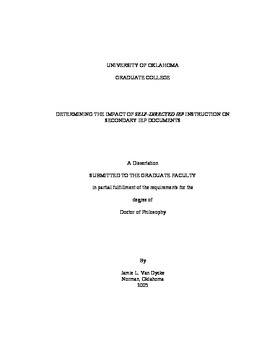| dc.contributor.advisor | Martin, James E., | en_US |
| dc.contributor.author | Van Dycke, Jamie L. | en_US |
| dc.date.accessioned | 2013-08-16T12:19:37Z | |
| dc.date.available | 2013-08-16T12:19:37Z | |
| dc.date.issued | 2005 | en_US |
| dc.identifier.uri | https://hdl.handle.net/11244/829 | |
| dc.description.abstract | The lack of vision component representation across the IEP raises concerns, given the 2004 IDEA amendments, which reiterate that the purpose of special education is to prepare students for further education, employment, and independent living. Implications include the need for specific materials designed to increase IEP vision development and the infusion of the four vision components into key areas of the IEP. Field-initiated research to validate the implementation of such materials is also needed. | en_US |
| dc.description.abstract | I wanted to determine if Self-Directed IEP instruction impacted three things in secondary IEP document development: (1) student ownership of the IEP; (2) complexity of postschool goal/vision statements in IEPs; and (3) infusion of the four vision components of living, learning, working, and community involvement, into other key IEP areas. I examined 94 secondary IEP documents (including 92 postschool goal/vision statements) for the presence of four vision components using a scoring rubric. Pilot study and inter-rater reliability procedures established the validity and reliability of the rubric. The IEPs had been developed during Year 2 of a federally sponsored field-initiated research grant that used a randomized control/intervention group design. The secondary students represented in the documents had mild/moderate disabilities and had randomly received Self-Directed IEP instruction to increase student participation in IEP meetings. | en_US |
| dc.description.abstract | Study results indicate that the Self-Directed IEP had a moderate impact on the complexity of the vision statements, with vision statements in the intervention group being more inclusive of the four vision components, specifically living and working. The instruction had no influence on student first-person references in the IEP document. The intervention had no impact on the general features of the vision statements, such as their writing style, futures orientation, or support through planned courses and coordinated activities. The Self-Directed IEP did not influence the vision components being addressed within or across specific sections of the IEP, other than the vision statement itself. | en_US |
| dc.format.extent | xvii, 155 leaves : | en_US |
| dc.subject | Self-management (Psychology) for teenagers Study and teaching Activity programs. | en_US |
| dc.subject | Decision making Study and teaching (Secondary) Activity programs. | en_US |
| dc.subject | Vocational guidance Study and teaching (Secondary) Activity programs. | en_US |
| dc.subject | Student aspirations Study and teaching (Secondary) Activity programs. | en_US |
| dc.subject | Education, Special. | en_US |
| dc.subject | Self-directed IEP. | en_US |
| dc.title | Determining the impact of self-directed IEP instruction on secondary IEP documents. | en_US |
| dc.type | Thesis | en_US |
| dc.thesis.degree | Ph.D. | en_US |
| dc.thesis.degreeDiscipline | Department of Educational Psychology | en_US |
| dc.note | Source: Dissertation Abstracts International, Volume: 66-01, Section: A, page: 0142. | en_US |
| dc.note | Adviser: James E. Martin. | en_US |
| ou.identifier | (UMI)AAI3161635 | en_US |
| ou.group | Jeannine Rainbolt College of Education::Department of Educational Psychology | |
